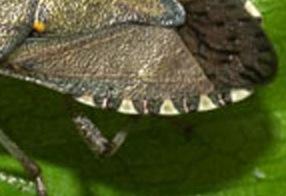General Information
The first reported occurrence of the brown marmorated stink bug in the United States came at Allentown, Pennsylvania in 2001, but they are suspected as having been there earlier. Since that time it has moved north and south into most states on the east coast and many states westward across the country. One means of dispersal, for example, has been travel trailers which serve as good overwintering shelters and move hundreds of miles. In North Carolina they were first detected in the Winston-Salem area in 2009.
This Asian stink bug feeds on a variety of hosts in the landscape including butterfly bush (Buddleia), pawlonia, hibiscus, zinnia, and sunflower, to name a few. They also attack fruit trees (ornamental or otherwise). They have potential to do damage to commercial apple, peach, soybean, cotton and other crops. In some areas of the country they are more numerous than the native green stink bug. They may inflict leaf and fruit damage from feeding with needle-like mouth parts.
Perhaps the biggest problem for homeowners is the overwintering behavior where the bugs may collect seeking shelter in homes and structures, similar to the multicolored Asian lady beetle. They don't harm people, but can give off an unpleasant odor when crushed or vacuumed. Appearance in houses begins about late September to October.
Identification
Adults are slightly larger than 1⁄2 inch. The overall coloring may vary from brown to gray. Distinguishing characteristics are the white and dark banding on the antennae on the next-to-last antennal segment, red eyes and ocelli, and black and white bands along the outer edges of the thorax. It has a smooth, untoothed shoulder. Though there one or two similar looking stink bugs, this is the only stink bug that aggregates in houses in large numbers.
Biology
Egg masses are laid in midsummer by the overwintered females. There are five nymphal stages that go through different colorations and markings. Each stage takes about one week. New adults emerge late summer, but don't move to overwintering areas for another month or two. We do not yet know if there can be two generations in North Carolina.
Control
Outdoor
For damage on plants, the normal stink bug procedures should be effective depending upon which plant or fruit tree you may wish to protect. The North Carolina Agricultural Chemicals Manual has recommendations.
Outdoor chemical barriers sprayed on a house or structure containing a pyrethroid may be somewhat helpful, but the residual effectiveness of the chemical will be short. Creating a physical barrier to their entrance is the best preventative. Make sure window screens are in place and check around window air conditioning units.
Indoor
Barrier exclusion is the best control. Seal and caulk and areas that may give access to the wall or house. If this is not completely successful and stink bugs are entering the living quarters, seal or caulk around baseboards, window sills, and any points at which you may detect them coming into the structure. Aerosol foggers (flea bombs) are not generally suggested. They may kill some exposed bugs, but will not kill bugs in the wall, and the danger of fire hazard when using these products adds to the risk of their use. A handheld aerosol spray can product may be somewhat effective in spots where they routinely collect, but vacuuming is a pesticide-free alternative, though it may be a little more work. It may be best to use a piece of ladies' hose over the hose end and discard them soon after so the vacuum cleaner does not hold the stink, long after the bugs are gone. Some people use a dedicated shop vac so as not to impart the odor to their household vacuum cleaner. Currently, feeding and mating attractants are being tested.
- Adjust or install tight-fitting sweeps or thresholds at the bottom of exterior doors.
- Install weatherstripping around other parts of the doorframe.
- Seal utility openings where air conditioner pipes, phone, cable TV and other wires enter the foundation and siding. Holes can be plugged with caulk, cement, urethane foam, or copper mesh.
- Caulk around windows, doors, siding and fascia boards.
- Keep window screens in good condition and install insect screening behind attic gable vents.
Other Resources
- Oregon Identification Note Alert
- Brown Marmorated Stink Bug (University of Florida)
- Brown Marmorated Stink Bug (Penn State)
- NC State Extension Plant Pathology Publications
- NC State Horticultural Science Publications
- North Carolina Agricultural Chemicals Manual
Based on a USDA APHIS invasive species report. Photos from Bugwood.org, Gary Bernon, David Lance and Buglady Consulting.
For assistance with a specific problem, contact your local Cooperative Extension center.
Publication date: Sept. 1, 2009
Reviewed/Revised: Nov. 18, 2020
Recommendations for the use of agricultural chemicals are included in this publication as a convenience to the reader. The use of brand names and any mention or listing of commercial products or services in this publication does not imply endorsement by NC State University or N.C. A&T State University nor discrimination against similar products or services not mentioned. Individuals who use agricultural chemicals are responsible for ensuring that the intended use complies with current regulations and conforms to the product label. Be sure to obtain current information about usage regulations and examine a current product label before applying any chemical. For assistance, contact your local N.C. Cooperative Extension county center.
N.C. Cooperative Extension prohibits discrimination and harassment regardless of age, color, disability, family and marital status, gender identity, national origin, political beliefs, race, religion, sex (including pregnancy), sexual orientation and veteran status.






